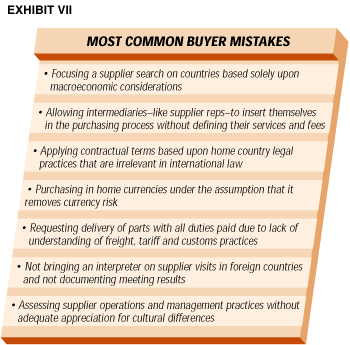고정 헤더 영역
상세 컨텐츠
본문

Spend Matters welcomes this guest article by Shruti Agrawal, director at Excella Worldwide.Global product sourcing refers to a procurement strategy through which an enterprise works to identify the most cost-effective location for product manufacturing, even if that location may be in a foreign country.For instance, a cement manufacturing company may find that the costs of raw materials and manufacturing are lower in some foreign country because manpower is cheaper there. The company would therefore opt to shut down its domestic operations and set up a plant in that foreign country.The general sourcing process can be divided into the following 5 stages, explained below. Stage 1: Preliminary Research – Investigation and TenderingAt this stage, the enterprise identifies the core and non-core operational activities, analyzes customer and market requirements and identifies competitors. The idea is to develop the firm’s business objectives, prospective markets and brand positioning.The strategic sourcing scope is also outlined through a business plan developed by the executive and the sourcing specialist, and the preliminary work strategy and baseline for measuring performance is established and documented as a procurement process plan.
Stage 2: Market and Supplier EvaluationAt this stage, the enterprise develops a detailed list of supplier selection benchmarks, which is used to select the most appropriate suppliers that fit the requirements. Based on the findings of the process, the sourcing strategy may be tweaked further and a final costing model is released.
The operational and economic benefits of the project will then be estimated. RFIs will then be sent out to the shortlisted suppliers. Stage 3: Selection of the Supplier (Sourcing Event)Based on the results of the RFI dispatch, a final list of suppliers is selected and negotiation for products is carried out, culminating in a supply agreement.
Technical assessment of final supply candidates is conducted to come up with the savings estimates for each. Finally, an implementation schedule outlining timelines for various suppliers is developed. Stage 4: ImplementationA performance analysis schedule should be developed, outlining all activities in the implementation process. The implementation team should be constituted by the procurement agent and the schedule and strategy should be published.
Global Sourcing News
Agreements related to shared supply, resources and logistical arrangements are developed.At this stage, expected internal and external results from the suppliers should be documented. Periodic measurement and reporting of actual performance should be carried out. Stage 5: Performance MonitoringPerformance of suppliers is measured, both independently and in relation to the resources and processes applied by supply partners. This should be carried out routinely and reported accordingly. In-depth evaluation of the efficacy of collaborative efforts with each supplier is obtained, and the partners involved continuously isolate problems and find out ways these can be solved for improved performance.The objective of performance monitoring is to maintain the most efficient procurement process, one that is flexible and dynamic, easily adapting to a changing market environment. A Good Global Sourcing Strategy Addresses. Cost – the main purpose of product sourcing strategy is to take advantage of lower labor costs in foreign countries.
However, the procuring organization will face additional costs that don’t factor into domestic transactional costs. These include broker fees, freight charges, taxes called, insurance, duties and bank fees. Laws – the sourcing specialist together with the supplier should consider what body of law shall be applied to their contractual agreement, i.e., the buyer’s country’s law, the supplier’s country’s law or the law applicable through a signed treaty between the 2 countries.
Global Sourcing Strategy
Currency – some buyers may insist on transactions in their own currency for the sake of simplicity. However, a prudent buyer will consider the possibility of using the supplier’s currency where the buying country’s currency may become stronger in the period between agreement and supply and eventual payment. Lead time – global purchases have a significantly longer lead time than domestic sources. The reason is that overseas travel is slower, unless air travel is used.: Jason Busch said: Bravo Nick.
Excellent piece. The need for true 'procurement analytics' has never been greater at.: Margaret said: My customer uses Ariba and I find it very difficult to invoice them. The system sends back invoices.: Scott said: Quality control is a critical issue when hiring freelancers remotely. Poor quality or poor execution.: John Tight said: The outsourcing company should be flexible.
The terms and conditions on which they work should be fl.: Esther Ho said: This is just happened to us too and not only, they billed us x amount and charged us x amount + a fe.




